Travel Guide to Meghalaya Root Bridges
I will be honest. I did not know the living root bridges exist. Friends we met on the Andaman Islands told us about this miracle of man and nature coexistence and I suspected, this will be one of the most amazing places on this little planet. After we left Andamans we headed straight to Meghalaya to witness living root bridges with our own eyes.
The information how amazing the bridges are was accompanied by the warning, that steep vertical terrain will be a no go for our two children, aged 2 and 6. "No, you can not go to Double Decker, that is too difficult", we heard again and again. We did it and this is our guide to Meghalaya root bridges for you.What are living root bridges?
For more details about root bridges, check our previous article here: Living Root Bridges of Meghalaya
Getting to living root bridges - The unusual way.
When you look at the map, you will realize, that the Khasi hills are facing plains of Bangladesh down below them. Therefore, one unusual alternative is reaching Root Bridges from Bangladesh, via Dawki border crossing. (Have you visa stamped in your passport before you try.)
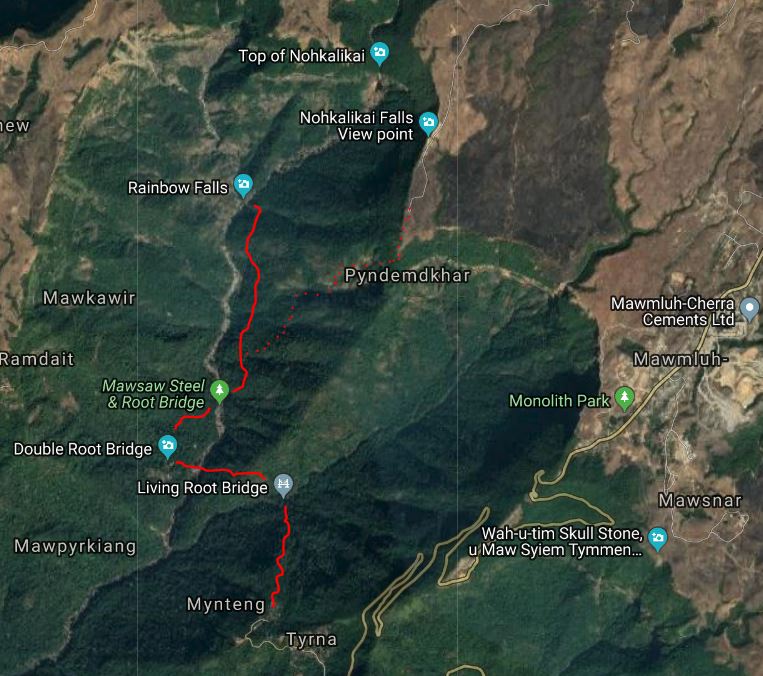
Nongriat Area Map data (C) 2019 Google
Getting to Meghalaya living root bridges - The usual way.
First by air to Assam or Meghalaya
All Indian airlines connect multiple Indian cities with the capital of Assam, the city of Guwahati. Flight are frequent, competition high and prices low. There is also a “Shillong airport”, at the village of Umroi, some 1-hour drive from the Shillong itself. This is a small airport with the less frequent connection. Check the price and timing of flights to Shillong, if nothing reasonable is found, fly to Guwahati. Meghalaya Transport Corporation (M.T.C.) runs a bus from Umroi Airport to town. It costs 100,- RS per person. Make sure you catch it, the taxi cost would be ruinous.
From Guwahati airport to Shillong by bus or taxi.
From Guwahati airport, you have multiple options. Best is to ask around the parking lot to see if there are shared taxis, jeeps directly to Shillong. This is your fastest bet, it will take anywhere from 3,5 to 5 hours to reach Shillong.
The second best option is the direct M.T.C. bus between Shillong and Meghalaya Airport. It departs Shillong at 6:30 a.m. and 9 a.m. and departs Guwahati airport at 2 p.m. and 4 p.m. The fare is Rs. 250,-
Alternatively take an airport bus to the Guwahati bus station in the city centre, from where you can take either bus or shared taxi to Shillong. Obviously, the bus will be cheaper and less convenient. For the taxi, prepare to pay 350-500 Rs per person, depending on the car and number of sharing passengers.
One option, which sounds pretty good to me, is using the Meghalaya Helicopter service. Price is acceptable: 1500 Rs per passenger, one way. Choppers land near the Shillong city, e.g. not at the distant airport and the flight duration is 30 minutes only.
Crossing a steel bridge above Mawsaw river
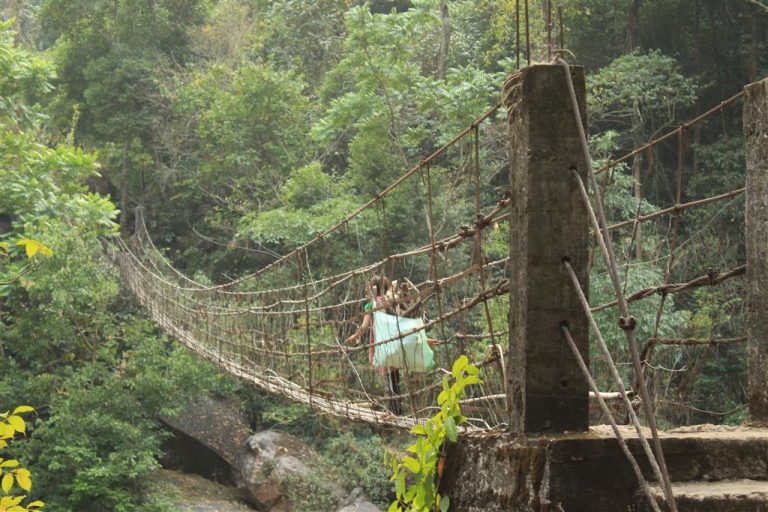
Travel from Shillong to the living root bridges.
Next thing you should decide for yourself is what actually you want to see. Shall you just visit the easily accessible root bridge near the so-called “cleanest village” or are you fit for trekking to Double Decker and beyond (Yes, you are! Maybe you just do not know about it.)
Travel from Shillong to the cleanest village, easy living root bridge and Dawki.
The most popular day trip from Shillong, suitable even for the laziest ones. You will visit Riwai living root bridge; Mawlynnong, touted as “the cleanest village in Asia” (quite a nonsense, btw.) and Dawki village, with this time “the cleanest river” in India, called Umgnot. I must admit, the river is worth the visit.
Even if public transport heading to Dawki exists, the complete trip can only be done with Taxi or tourist bus. Price for taxi per full day starts at 2000,- Rs for small Maruti. Tourist bus costs 500,- Rs per person.
The only risk of this trip is, that once you realise how amazing the root bridges are, you will want to see more. ?
Check our Meghalaya Root Bridges Trailer Video
SUPPORT US 🙂 CLICK THE ADD IF YOU LIKE IT. Thank you.
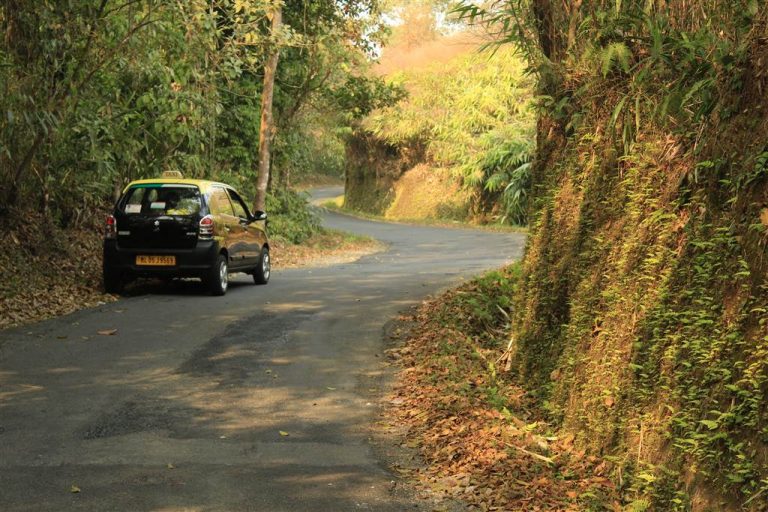
The road from Cherapunjee to Tyrna
From Shillong via Cherapunjee to Tyrna (for Double Decker living root bridge) by Bus
Once you got used to the fact, that things like transport are cheap in India, you will face painful truth in Meghalaya. Transport is cheap only if you move between populated places together with other local inhabitants. Meghalaya is mountainous and sparsely populates the state of India and you are heading where mostly tourists and not locals go. You will need a taxi. Prepare a thicker wallet.
Public bus and shared jeeps travel in Meghalaya
There should be a bus between Shillong and Cherapunjee (Sohra). This bus is not run by M.T.C. We heard it is cheap, mostly crowded, infrequent and it leaves early morning from the Police Bazar (that is how the city center is called here). Ask at M.T.C. bus station what the departure times are and check around if any shared taxis may be available. At the time of our visit, they were not. If you travel on a very tight budget or you are alone and a taxi would be out of your budget, take the bus to Cherapunjee.
However there are shared jeeps from Shillong to Cherra Punjee, then to Tyrna and vice versa. Direct shared jeeps from Shillong to Tyrna leaves at 2:00 -2:30 PM from the 1st parking lot (Bara bazaar) and Tyrna to Shillong at 7:00 AM and 1:00 PM.
Meghalaya Tourist bus
The alternative to the local bus would be a tour bus run by Meghalaya Tourism Development Corporation. They run a day trip from Shillong towards Cherapunjee, stopping at main tourist points like caves and waterfall. This tour returns back to Shillong, however you may get off at Cherapunjee and continue further on to Tyrna. Price is 350,- Rs per person which makes a lot of sense compared to a taxi.
Once you reach Cherapunjee, your choices will be similarly limited. There will be a transport once or twice a day going to Tyrna or passing by, that can drop you at Tyrna or at a nearby crossing, from where you could walk. However, it is very likely that you will need a Taxi from Cherapunjee to Tyrna.
Travel from Shillong via Cherapunjee and Tyrna (for Double Decker) by Taxi
Taking a taxi is expensive, but makes a lot of sense. Similar to the tourist bus, a taxi driver will stop for you at most of the interesting points en route. A taxi will also cost from 2000,- Rs per day. Saying that, please think twice before you decide to do Double Decker as a one day trip from Shillong. Count on a minimum of 2.5 hours nonstop driving time there and another 2.5 hours back. Then you need time to descend those 3700 steps from Tyrna to Nongriat (where the Double Decker is) and time to climb them back. When will you enjoy the bridges and scenery? Do not do it and read on:

Crossing a root bridge
Planning and timing your visit to Double Decker living root bridge
Let me offer you 2-3 reasonable alternatives on how not to exhaust yourself and enjoy what you came for to the fullest.
Option 1. We did it this way.
Day 1. Take a taxi from Shillong to Tyrna, making a stop or two on the way. Reaching Tyrna, get something to eat and start descending to the valley. Stop at the amazing “Long bridge” en route. You will reach Nongriat later in the afternoon, check the Double Decker and overnight in Nongriat.
Day 2. Do not go back! Spend the next day fully in Khasi hills. Trek from Nongriat to the Rainbow Falls. This trek is even more amazing than the one you did a day before. Return to Nongriat to spend the second night there.
Day 3. Climb up back to Tyrna. You’ll already know how amazing the Long bridge is, thus you will visit it again. Arrange your taxi driver to wait for you in Tyrna around 2 pm and return to Shillong by evening, making a stop or two if you have any energy left.
The only disadvantage of this option is the high cost of paying 2 x 2000 Rs for the taxi.
Option 2.
If you want and can reach Cherapunjee cheaply by bus from Shillong, then do so. If there is a chance to also reach Tyrna on the same day, do so. Tyrna is only 30 minutes by car from Cherapunjee, however, transport is very infrequent. If you overnight in Cherapunjee or Tyrna you will have more time to spend in the hills, compared to starting your day in Shillong. For the rest of the plan, follow the option 1.
My suggestion here is to contact one or two accommodations in both Cherapunjee and Tyrna and check what the latest transport options are on the Tyrna - Cherapunjee - Shillong route.
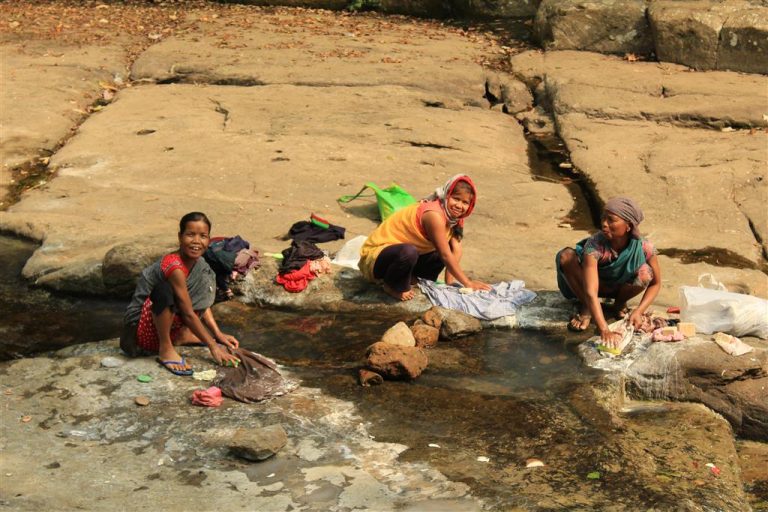
Dry season by Riwai village
Journey from Tyrna to Nongriat (Double Decker) via the Long Bridge
Once you set foot in Tyrna, the journey continues on foot from here. It is said to be 3700 steps down to reach Nongriat. Plus or minus, it can be so. The first part of the hike is literally stairs only. Just down, down, down. When you reach the crossing with a detour to the long bridge, you are half way thru and the worst is over. On the way back it is a stairway to heaven.
Meet Ritimmen, the long living root bridge.
Ritimmen is the name of the famous long bridge, that you should visit on the way to Double Decker. Some sources claim this is the longest living root bridge on Earth. In fact the longest one is near the small Khasi town of Pynursla. To me, the Ritimmen is more spectacular than the Double Decker. Make sure you do not miss it. There is a nominal fee to enter the Ritimmen area: 10Rs per head plus 20Rs for the camera.
Double Decker, the Meghalaya's most famous living root bridge.
It may take you 1-1,5 hour to descend to Ritimmen and another 1-1,5 hour to reach the Double Decker. Take it slowly and enjoy the scenery. You will reach Nongriat settlement after crossing the long metal bridge over an amazing river valley. There is also a nominal fee to enter the Double Decker, slightly more than the Ritimmen.
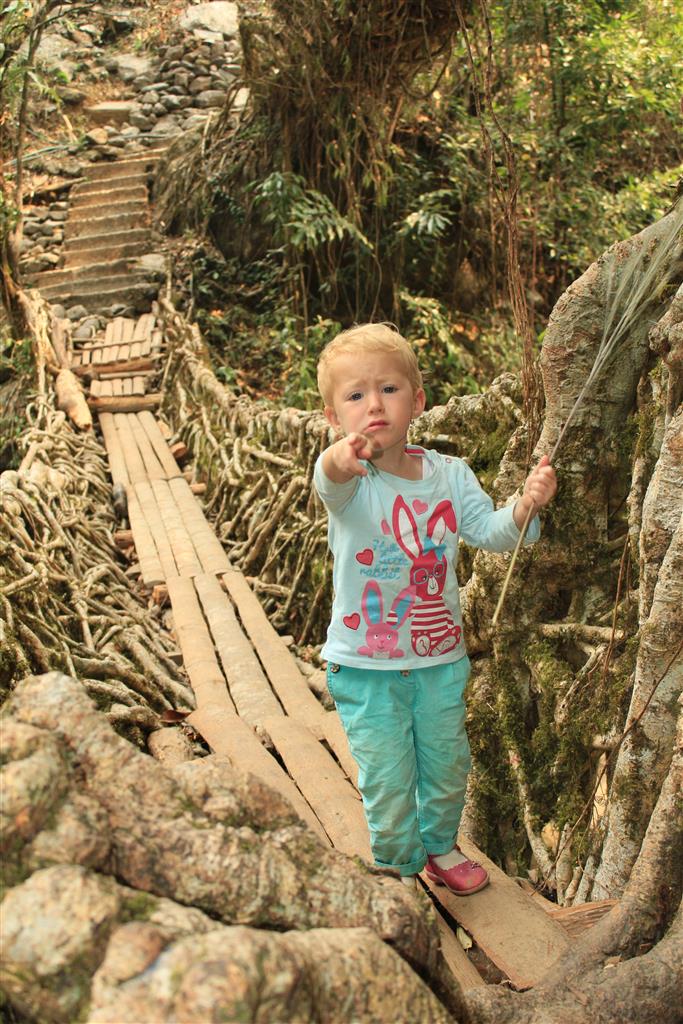
You can do it!

Stairway to heaven
What is the best time to visit living root bridges in Meghalaya
Meghalaya is probably the only place I know, where visiting in the rainy season makes a lot of sense. My opinion is that you can visit anytime, rainy or dry season, each has advantages and disadvantages. The ideal time is just as the monsoon ended. We have visited in the dry season. The advantage of the dry season is, obviously, dry terrain and easier trekking. However, the disadvantage is the dry rivers. If you want to take amazing pictures of the bridges, it would be nice to have some rivers flowing under them. At the mid to end of February, the rivers were mostly dry and the waterfalls shrunk to a trickle.
Obviously, the advantage of visiting during or shortly after rains is that the waterfalls will be majestic and river crossing thrilling. However, trekking to places like Rainbow Waterfall may be very muddy and slippery.
Bridge above Mawsaw river
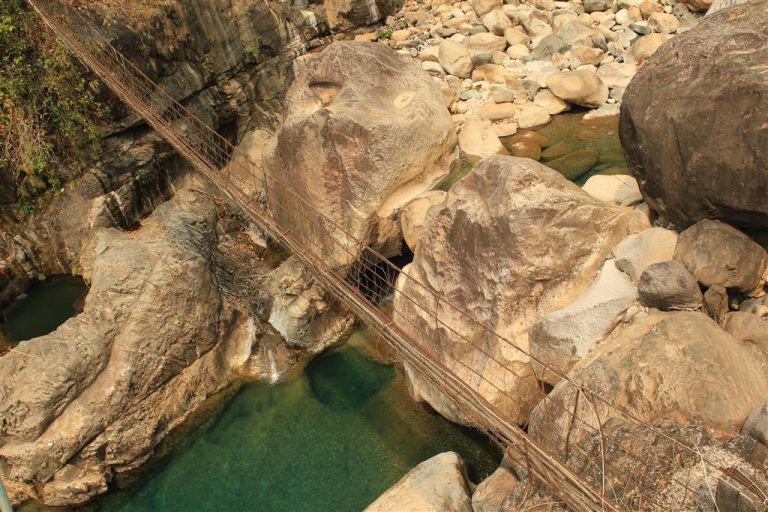
Accommodation and food around Meghalaya living root bridges
Tyrna is the last point where cars and small trucks can reach. Therefore it is the last point to grab any last minute supplies. Tyrna itself is a pretty small and remote village, therefore you are better off to take supplies from Shillong or Cherapunjee.
There a few snack stalls along the way, selling tea, biscuits and occasionally a pineapple. Cooked food you can get in your accommodation and be prepared for the food to be simple. The best food is served at Serene Homestay.
Nongriat is the only village with any accommodation options on this trek. There are 4 or 5 small homestays in the village. Please be realistic in expectations and book your homestay ahead. The capacity of those 4-5 places is limited. The worst thing that can happen to you is that all are full and you need to climb back the same day, to sleep in Tyrna. I do not think this happens often and I strongly believe locals will go out of their way to accommodate you, but still, it can happen.
On the other hand, some accommodations we have seen, do not have a permanent “reception”, just a phone number hanging on the doors. The owner may not be nearby, thus calling ahead makes a lot of sense.
How fit do I need to be to trek to Double Decker living root bridge?
The best way to answer this question is to tell you that we managed the trek with 2 children, aged 2 and 6! Saying so, I must admit that the trek is difficult. You are descending 3500 stairs and climbing them back, overcoming a few hundred meters of elevation. Take your time and do not rush it. As I mentioned above, budget for 2 nights in Nongriat, that will give you time for the rest and you will be fine.
There is only one case, where I would advise against trekking to Nongriat. If you have a problem with your knees, think twice before you go. Visit a tall building and try to walk to 20th floor and back by stairs 10 times and see how your knee reacts.
SUPPORT US 🙂 CLICK THE ADD IF YOU LIKE IT. Thank you.
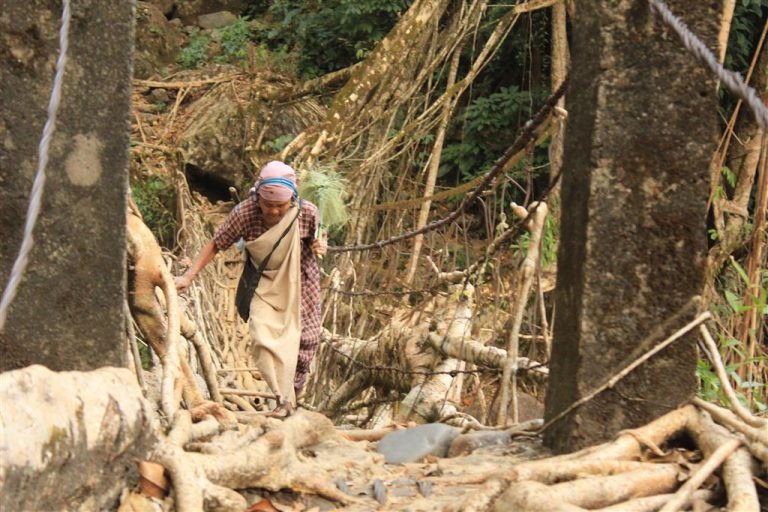
Root bridges are essential for locals
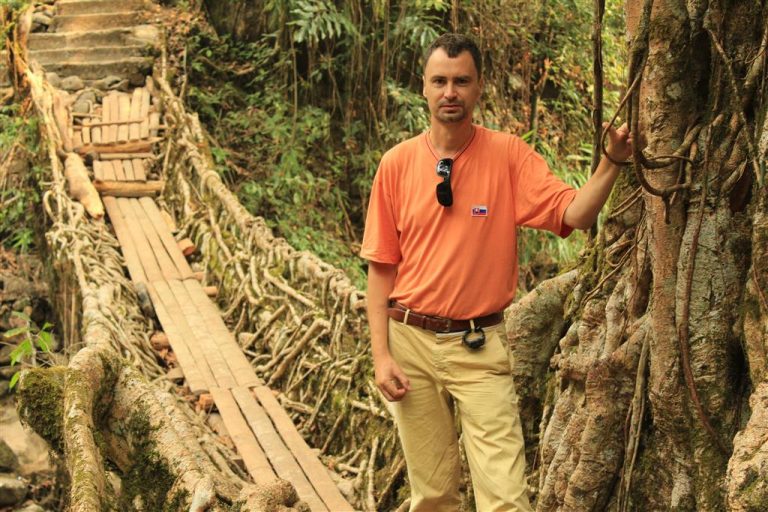
@ Double Decker
Trek from Nongriat to Rainbow Falls and back
After reaching Nongriat, you have a choice of going back to Tyrna (which would be a pity) or going to rainbow falls and back (which for most people maybe be too much for one day) or staying for the night (which is the right thing to do). Sleep well and with energy recharged, head to Rainbow Falls. Journey to Rainbow Falls is amazing, beautiful and thrilling in some parts. You will need to overcome Mawsaw steel bridge, hanging over the river valley, encounter a few root bridges on the way and splash in the natural pool before you hit the scenic waterfall.
Trek from Nongriat to Rainbow falls and back is different and somehow more difficult then the Tyrna - Nongriat part. The first thing, that makes the trek more difficult is, that the path is not “paved” by firm stairs, as the patch from Tyrna was. While the path is clearly visible and there is no need for a guide, it may be muddy and slippery in parts, especially after the rain. The second thing makes it easier. To get to Rainbow falls, you do not need to overcome huge elevation differences. The trek is slightly uphill, but not steep.
If you do not have the full day to go to Rainbow Falls, but you have some spare hour or two, just walk some 30 minutes from Nongriat to Mawsaw steel bridge and enjoy the thrill and scenery crossing it.
On more option for those with real mountaineering strength
There is a detour you can see on the map at the beginning of this article. Halfway to Rainbow Falls, you can locate a very steep path that will lead you to the Nokhalikhai Falls viewpoint. This way may seem like a shortcut to be used for the journey back. Sure you can use Nokhalikhai Falls viewpoint a starting or ending point of your Rainbow falls - Double Decker - Ritimmen hike. However please be aware the steps here are very very steep (steeper than steps from Tyrna) and you must be strong and fit to take that path. An advantage would be that the viewpoint is easy to reach from Shillong on the tourist bus, that could save you time and effort of getting to or from Tyrna.
Accommodation and food in Nongriat
Tyrna is the last point reachable by cars and small trucks, thus it is the last point to grab any last minute supplies. Tyrna itself is a pretty small and remote place, it is better to take supplies from Shillong or Cherapunjee.
There a few snack stalls selling tea, biscuits and occasionally a pineapple along the way from Tyrna down to Nongriat. Cooked food you can get only in your accommodation. Be prepared: the food is pretty simple. The best food is served at Serene Homestay.
Nongriat is the only village with any accommodation options on this trek. There are 4 or 5 small home-stays in the village. Please be realistic in expectations and book your homestay ahead. The capacity of those 4-5 places is limited. The worst thing that can happen to you is that all are full and you need to climb back the same day, to sleep in Tyrna. I do not think this happens often and I strongly believe locals will go out of their way to accommodate you, but still, it can happen.
On the other hand, some accommodations we have seen, do not have a permanent “reception”, just a phone number hanging on the doors. The owner may not be nearby, thus calling ahead makes a lot of sense.
SUPPORT US 🙂 CLICK THE ADD IF YOU LIKE IT. Thank you.
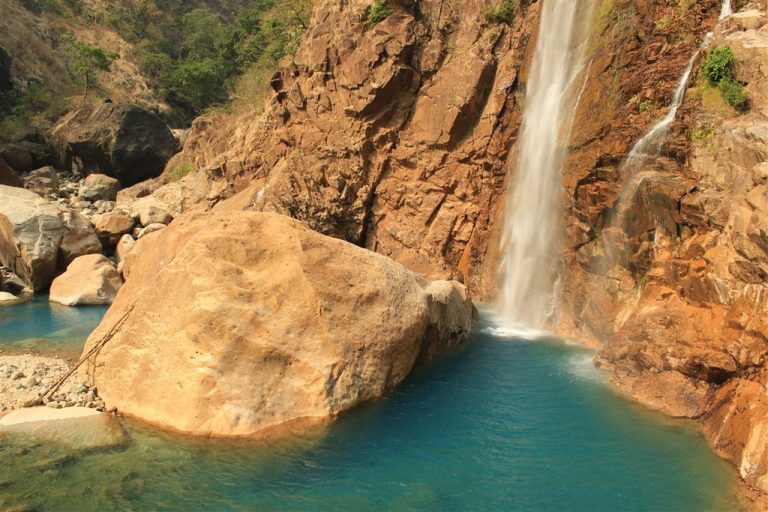



Got something to add? Comment on the post here: